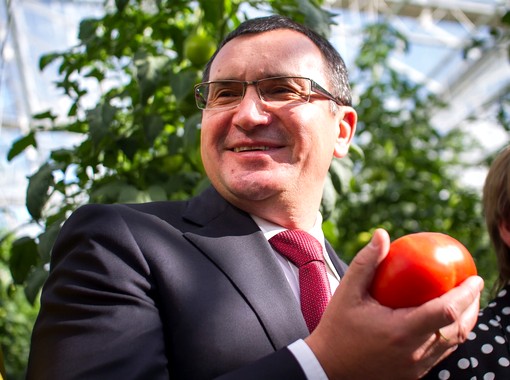
Russia saw its grain harvest decline in 2015 by one million tons to 104.3 million tons, mainly due to the reduction in the harvests of barley, rye, and oats.
According to the data of Rosstat, the barley harvest fell to 17.5 million tons from 20.4 million tons in 2014. The harvest of rye decreased to 2.1 million tons from 3.3 million tons. The harvest of oats dropped down to 4.5 million tons from 5.3 million tons.
The harvest of triticale was 564,000 tons, against 654,000 tons collected in 2014.
At the same time, the harvest of millet rose to 572,000 tons, against 493,000 tons in 2014. Grain legume crops harvest rose to 2.4 million tons from 2.2 million tons.
Wheat harvest
In 2015, Russia increased the harvest of wheat by 3.5 percent to 61.8 million tons, against 59.7 million tons in 2014, the Agriculture Ministry said.
In addition, there were record harvests for grain corn – 12.7 million tons, which is 53.8 percent more than the average for the last five years (in 2014, the harvest was 11.3 million tons) – and rice – 1.11 million tons, against 1.05 million tons in 2014.
A total of 860,000 tons of buckwheat was harvested, which is a figure representing a 25.4-percent increase relative to the average harvest for the last five years. In 2014, the buckwheat harvest was 662,000 tons. “This is enough to fully cover domestic demand,” the Ministry said.
The total harvest of grain crops stood at 104.3 million tons, against 105.3 million tons in 2014.
Among the achievements of crop growers, the Agriculture Ministry also noted the record harvest of soy – more than 2.6 million tons by weight after processing, which is 58.3 percent higher than the average harvest for the last five years (in 2014 it was 2.4 million tons) – and for flax seed – more than 500,000 tons, which is 54.1 percent more than the average for the past five years (385,600 tons in 2014).
The harvest of sugar beets amounted to 37.6 million tons, against 33.5 million tons in 2014. More than five million tons of beet sugar will be processed out of that sugar beats harvest. The harvest of sunflowers rose to 9.2 million tons, against 8.5 million tons in the previous year.
The harvest of potatoes at farms of all categories (agricultural organizations, farms, private farms) amounted to 33.6 million tons, which is 15.9 percent more than the average harvest for the last five years (31.5 million tons in 2014). A record amount of vegetables was harvested – 16.1 million tons (15.5 million tons in 2014), which is 12.3 percent more than the average harvest for the last five years.
The fruit and berry harvest rose by nine percent in comparison to the average harvest for the last five years to 2.9 million tons. In 2014, the harvest stood at three million tons.
Export volumes
Russia exported 20.767 million tons of grain in the current agricultural year (July 2015 to June 2016) through mid-January, a number that was four percent less than the 21.571 million tons exported in the corresponding period of the previous year.
Wheat accounted for the bulk of grain exports, or 15.524 million tons. Russia also exported 3.267 million tons of barley, 1.806 million tons of corn, and 168,000 tons of other crops.
The grain export potential in the current farm year is 30 million tons, according to the Agriculture Ministry’s estimates under the moderate-to-conservative forecast.
The bulk of the exports were shipped from ports in the Krasnodar krai and the Rostov region.
Russia exported 35.57 million tons of grain in calendar year 2015, including 21.72 million tons of wheat. Exports of grain and grain products in the current agricultural year through January 12 amounted to 23.6 million tons, including 16.53 million tons of wheat that accounts for 70 percent of the total. Exports in the 2014-2015 farm year totaled 26.4 million tons, including 18.48 million tons of wheat.
Russia exported 18.2 million tons of wheat and wheat-and-rye mix worth USD3.415 billion from January to November 2015, the Federal Customs Service (“FCS”) said. The figure was 9.5 percent below the 20.11 million tons that Russia exported in the corresponding period of 2014, with the total value of USD4.951 billion.
Russia imported 303,700 tons of grain worth USD61.1 million, down from 364,300 tons at USD86.8 million one year earlier.
Barley imports fell to 37,800 tons (USD5.1 million) from 167,800 tons (USD40.1 million), and corn imports to 32,800 tons (USD105.9 million) from 44,200 tons (USD186.3 million).
Export markets
Egypt and Turkey remained the leading importers of Russian grain in the first half of the current agricultural year, the deputy head of the strategic marketing department at Rusagrotrans Igor Pavensky told Interfax.
Egypt imported over 3.9 million tons of grain, or 18.2 percent of Russia’s total grain exports in the reporting period, and Turkey imported 2.8 million tons, which represents a 13.1-percent share of overall exports. The exports to Egypt were down somewhat from the 4.06 million tons imported in the corresponding period of 2014, while the exports to Turkey increased from 2.64 million tons.
Saudi Arabia was also a major buyer of Russian grain, boosting imports to 1.97 million tons (9.2 percent of the total) from 1.91 million tons a year earlier. Exports to Iran dropped 6.5 percent to 1.39 million tons, down from 1.9 million tons, a decline that was due mainly to greater imports of barley from Kazakhstan.
Other major importers of Russian grain were Bangladesh, Azerbaijan, South Africa, Yemen, and Libya.
Minor ports in the Azov-Black Sea basin shipped 9.4 million tons of grain from July to December 2015 (43.7 percent of total grain exports), compared to 8.9 million tons (42.5 percent) in the period of months from July to December 2014. Exports through deep-water ports totaled 9.5 million tons, or 44.3 percent of total exports. Exports from smaller ports stood at 9.3 million tons, accounting for 44.6 percent of overall exports. Novorossiysk port’s share of grain exports fell to 28.3 percent from 31.8 percent, while the share of the Taman and the Tuapse ports increased to 11 percent from 8.9 percent and to five percent from 3.9 percent, respectively.
Trade House Rif was the leading exporter in the six-month period, exporting 2.8 million tons of grain, or 13 percent of the total. The International Grain Company, the Russian subsidiary of Glencore, was in the second place, with 2.2 million tons, or 10.3 percent of the overall exports. Cargill took the third spot in the ranking of most significant exporters, with 1.44 million tons that reflect a 6.7-percent of total exports.
Commenting on the proposed change in the export duty on wheat, Pavensky said that the most appealing scenario for exporters is a zero duty rate. “But that cannot happen due to the state’s concerns over an excessively rapid outflow of grain from the domestic market,” he said. “Approval of an entirely new mechanism tied to global commodities quotations, for example the French international futures market, the MATIF, or other benchmarks is more likely,” he said.
The Agriculture Ministry plans to submit proposals to the government on the wheat export duty. The Ministry has not disclosed the options for adjusting the duty. Grain market watchers do not rule out a flat export duty or a duty tied to quotations on a major international exchange. The export duty is currently 50 percent of the customs value minus RUR6,500, but not less than 10 roubles per ton.












Leave a comment